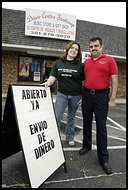|
 |
|
Esta página no está disponible en español. The Washington Post Tapping The Latino Market Store Owners Serving Growing Population By Ernesto Londoño July 13, 2003
This week's new movie: "Al Infierno con la Migra." Rough translation: The INS can go to hell. And that's putting it nicely. In the film, a Mexican immigrant arrives in the United States and stumbles into a drug-trafficking nun, a handful of crooked lawyers and the devil himself -- all while pursuing his green card. Forget the plot, though. What's significant here is the location of the movie rental store that carries the film and more than 500 other titles in Spanish: It's in Waldorf. Last year, seeing an untapped niche market in Southern Maryland, Edwin Santiago and his daughter, Dennisse, 21, opened Disco Centro Santiago, a variety store that caters to the area's mushrooming Hispanic population. "When I moved here in 1990, it was rare to hear Spanish around this area," said Edwin Santiago, 41. "Now, you see Hispanics everywhere. Every restaurant along 301, you go to the kitchen, and there's sure to be a Hispanic there." Many of the Hispanics in Charles County are men who left their native countries in search of work. Some entered the United States through the Mexican border and are here illegally. Many work two or three jobs and send the bulk of their earnings to their families back home. "These are extremely hardworking people," said Santiago, who emigrated from Puerto Rico in 1986 to join the D.C. police department. "They work that hard so they can send money to their kids." That's one of the services available from Santiago's store, at 11764 Central Ave. Each week, his customers send about $6,000 to their families through a courier service that costs $10 for transfers of up to $500. Prepaid phone cards and prepaid cellular phone plans also are quite popular. Then there are Bimbo pastries imported from Mexico, vintage bachata CDs (a traditional Dominican music), framed religious images with beaming neon lights, air fresheners in the shape of a sombrero and the quintessential Cuban guayabe (short-sleeved, loose-fitting embroidered shirts with four pockets). Oh, and let's not forget the sodas bottled in Mexico. "Mexican Cokes have more caramel," Santiago said. "They're still using the old recipe." Although, historically, big cities have lured immigrants in search of a brighter future, that is changing. Experts say that as the job market for low-skilled workers becomes saturated in large metropolitan centers, thousands of newly arrived Latin American immigrants are choosing to settle in smaller cities such as Waldorf, where the unemployment rate is low and the cost of living is more affordable. The population of Hispanics in Charles County is still small, but it is growing rapidly. In 1990, there were 1,691 Hispanics in the county; the 2000 Census counted 2,722 -- a 61 percent increase. Statewide, since the 2000 Census was conducted, newly arrived Hispanics have moved to Maryland at a staggering rate. According to U.S. Census Bureau data analyzed by the Center for Immigration Studies (CIS), from January 2000 to March 2002, the population of newly arrived Mexicans, El Salvadorans and Guatemalans increased from about 68,000 to 131,000. "That's really striking," said Steve Camarota, director of research at the center, a nonprofit think tank based in Washington. "This data shows us that the growth of immigration from Latin America to Maryland is unabated and enormous." In all likelihood, Camarota said, the rate at which Hispanics move to Southern Maryland will continue to increase. The sense of community and the consolidation of social networks make the area "more attractive for the next batch," Camarota said. "Maryland just feels more like home to them," he added. For almost three years, St. Peter's Catholic Church in Waldorf has been offering services in Spanish each Sunday. El Mercado, a mom-and-pop grocery store at 3101 Leonardtown Rd., owned by a Salvadoran couple, sells food products imported from Latin America. And Hispanic enrollment in the county's adult education English as a second language program increased 30 percent from 2001 to 2002. La Tolteca, a Mexican restaurant in Waldorf, is yet another meeting point for Latinos in the area. When the Magaña family moved to Charles County from northern California, opening a Mexican restaurant seemed like a risky venture. "We had heard that there was no Hispanic population here," said Veronica Magaña, 27, who runs La Tolteca, at 2708 Crain Highway, with her brother Marcos. "But it's been very successful -- totally not what I expected." The language barrier and transportation are two of the biggest challenges the area's Hispanic immigrants face. Since their immigration status prevents many of them from obtaining driver's licenses, some must rely on bicycles. "When it snows or rains hard, they have to wear ponchos or trash bags," Magaña said. Driving isn't the only problem. Many immigrants who are here illegally are hesitant to report when they have been victims of a crime, Magaña and Santiago said. "One guy got jumped at the mall last week," Santiago said, relating a story he heard from customers, "and he didn't call the cops because he thought he might get deported."
|

 ----------
----------